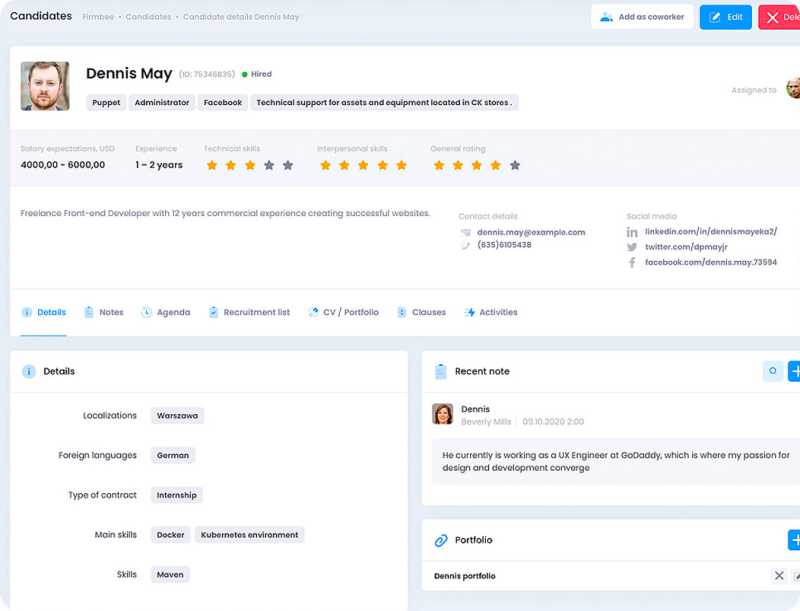Undeniably, UX study plays a key role in the entire UX/UI process. Its thorough analysis equips researchers and designers with data to design functionalities that more accurately match users’ needs and improve the new product or solution. With that in mind, you should put a lot of effort to devise a detailed plan of research and including user recruitment procedures.
It’s one of the key factors that will determine the success of your study. On what basis then, do you decide upon the quality of your sample (characteristics of one of your users) as well as quantity (the number of participants) sufficiently enough to make your study reliable and valuable? Read our post to know what is recruiting and see how to do it right.
UX study participant recruitment – table of contents:
- Recruitment of UX study participants
- How to pick your study sample?
- How many participants to include in a UX study?
- How to recruit UX study participants?
- Summary
Recruitment of UX study participants
Recruiting UX study participants have a strong influence on UX/UI process. Inviting the wrong people to take part in the study directly affects its outcome, distorts it delivering inconclusive results. You’ll have to retake it and reconsider the sample quality. Depending on the needs of the process, the course of the survey will vary significantly. The first step focuses on examining the characteristics of the project, defining the research problem, and determining what questions we have to get answers to. Solid preparation for the study and thoughtful recruitment of participants will enhance the testing, the following step to take.
How to pick your study sample?
When planning to recruit, keep an eye on the persona you devised before. It’s our perfect profile of the user – then consider how well the test participants match our profile. When narrowing down the number of participants, there are typically two courses of action. The first method recommends large-scale testing with a numerous, representative group, while the second focuses on specific requirements and looks for a more precisely defined participant. As always with so many variables, it all depends on the context, nature of research, capabilities of the team, the organization as well as the testing needs.
Large-scale testing – recommended by many UX practitioners – involves avoiding selective criteria for participants. After all, most products should feel easy and intuitive to apply. For the general demographic, this is exactly what we’ll achieve. An additional upside is that we will find participants relatively quickly (e.g. via online tools such as the User Testing platform). When planning to conduct a study that samples a general demographic group, make sure to:
- design it for a wide range of users
- make it functional and intuitive to anyone with no or little instruction
- take 15 minutes or less to test the product on one individual
The challenge with testing on a large demographic scale concerns mismatching participants with the profile of our ideal consumer. In such cases, we get valuable feedback but it’s not our target audience’s, which can make a big difference, especially when:
- we are dealing with a niche product or audience
- the product or research problem is complex and requires a certain level of prior knowledge or experience
- we aim at comparing the product to its direct competition
Under these circumstances, you should (if possible) narrow down the recruitment of study participants to people who match our user persona profile more.
How many participants to include in a UX study?
There are no clear guidelines on the recommended number of participants for a survey – it depends. The research specifics, resources, and budget, to name a few, influence it. In the case of surveying trends and opinions, a larger sample of participants proves handy in establishing quantitative statistics.
On the other hand, if you are testing a usability problem, you don’t need a very large sample. Studies show that 5 test participants will discover 85% of product usability problems – a satisfying result! Hence, by conducting 5 – 7 tests, you will eliminate most of the errors. The best way to approach the process is to apply changes to the design constantly and test til achieving the desired results. Such a solution is much more efficient and cost-effective (in terms of time and money) than running one extensive study with a huge number of participants.
How to recruit UX study participants?
Depending on the project and individual capabilities, different methods can be used to recruit participants for UX testing. One of them is the use of recruitment platforms – such as UserTesting, which we have already mentioned, but also many others like Sharewell, Teston, Validately, PlaybookUX, or Usertest.io. Venues of this type bring together millions of users willing to take part in testing. Designers can easily find their target audience there with just a few clicks.
Another method may be to recruit test participants from your customer base. This solution is advantageous in that the test subjects will be actual users of the product – who already know it well, know what it is used for and how to use it, and have an educated opinion about it. Feedback from our real users will always be more valuable than from people who have never dealt with it.
We can also recruit participants with the help of our website or social media – an announcement about the research we are conducting will help us reach our regular and satisfied customers, who will provide valuable insights during the study.
It is worthwhile at the outset to establish requirements such as age, income, gender, country, or knowledge of our product. Having prepared the profile of the ideal user – created based on the personas and data we have, statistics – we can begin further preparation for the study. Before the target survey, it is advisable to conduct screening tests (so-called screeners), which we will talk more about in the following articles. This ensures that we’ll only recruit those participants who match the user profile.
Firmbee can facilitate conducting recruitment thanks to a database of all candidates with recruitment statuses and ratings. You can also create candidates’ profiles where you can keep all crucial information.

Summary
Preparing for a UX study and recruiting its participants can be challenging – especially for less experienced designers. That’s why we’ve left a few more tips for you to implement in your work at the end.
Even before recruiting, make sure that the available options for answering the questions in the scenario are clear and understandable (you can do this by conducting a pilot study beforehand, which we wrote about in a previous article) and that the answers include “none” / “don’t know” / “other” response options (the user doesn’t necessarily have to have knowledge or opinions on a given topic).
When recruiting for a study, think about what matters to you, what effect you aim at, what research questions you source the answer to as well as what your target audience looks like. Outline an image of the potential survey participant, and determine whether you care about surveying existing users or people unrelated to the product undergoing study. Are they young or elderly? Affluent or living more modestly? What are their characteristics? What do they need? With all that in mind, you’ll easily establish tailored study incentives for participants and pick the right channels to recruit them.
If you like our content, join our busy bees community on Facebook, Twitter, LinkedIn, Instagram, YouTube, Pinterest,
Author: Klaudia Kowalczyk
A graphic & UX Designer which conveys into design what cannot be conveyed in words. For him, every used color, line or font has a meaning. Passionate in graphic and web design.
UX research:
- What is UX research?
- Types of UX research
- What are research questions and how to write them?
- Requirements gathering process for UI/UX projects
- Why are stakeholder interviews crucial for the design process?
- How to leverage our gathered customer data?
- How to create a good UX research plan?
- How to choose a research method?
- How can pilot testing improve UX research?
- UX study participant recruitment
- Channels and tools for finding UX research participants
- Screener survey for UX Research
- UX Research Incentives
- UX research with children
- Discovery research methods
- What is desk research?
- How to conduct user interviews?
- How to conduct diary studies?
- What are focus groups in research?
- What is ethnographic research?
- Survey research
- What is card sorting in UX?
- What is evaluative research?
- How to conduct usability testing?
- When and how to run preference testing?
- What is A/B testing in UX?
- Eyetracking in UX testing
- What is tree testing?
- First click testing
- What is task analysis in UX research?
- Evaluation of emotions in UX
- Continuous Research in UX
- Data analysis in UX research
- How to prepare a UX research report?
- Customer Journey Map – what is it and how to create it?


















